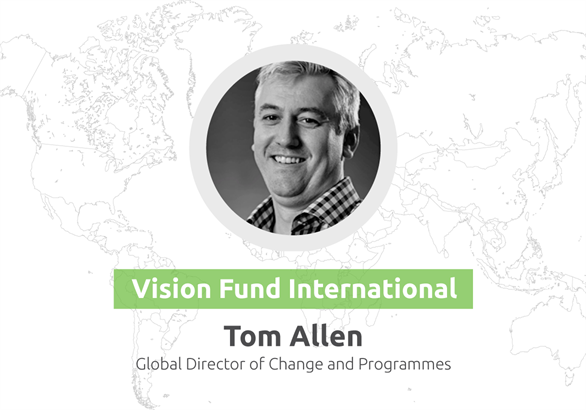Our clients are now able to pay their loans in a minute through their mobile phone instead of spending a whole day to and from a local branch.
We are pleased to introduce Mr. Tom Allen, Global Director of Change and Programmes, at Vision Fund International. We are discussing with Tom the specifics of the global microfinance business and how alternative delivery channels can elevate the operations of microfinance institutions. Vision Fund International (“VFI”) is one of the world’s largest microfinance networks. The company has 1 million + customers in 31 countries, operating across Asia, Africa, Latin America and Eastern Europe.
Hi, Tom, thank you for accepting our invitation to share your story in our blog. Could you please tell us more about VFI’s business and the challenges you face in the markets you operate in?
Vision Fund International is one of the world largest microfinance networks. The company has 1 million + customers in 31 countries. Most of the clients are small business entrepreneurs, with over 70+% being women. The mission and vision of VFI is to help these clients grow their income and help them and their families have better lives.
The challenges we face are very common in the microfinance industry. There were security threats because we were operating with cash in the field, we also suffered from extensive timelines to gather data and evaluate the clients in the credit process. Other challenges we face are in relation to lack of accessible data as our operations were paper based. Consequently, operating costs were high because of the slow and tedious nature of the manual processes. Our loan officers were not able to serve as many clients as desired and as such the cost ratios were higher.
With Software Group we introduced cashless and paperless banking for our business in Tanzania. We removed physical cash during the loan disbursement process by using USSD mobile application for end users and SMS notifications for transaction notifications. Furthermore, we implemented paperless banking to avoid the usage of physical paper for the loan application and loan approval processes. This was achieved with the tablet application for loan officers and integrated web front end in the branches for the branch managers. Now with using the applications from Software Group we can increase client and loan officer ratios which is very beneficial from a client interaction and service perspective as well as the arising cost saving perspective.
Could you tell us more about your IT landscape before implementing alternative delivery channels?
All of our business processes were manual, paper based. While we operated a robust core banking system; there were no other means to approach the clients other than loan officers in the field with paper application forms which then returned to the branch for data entry. All of this made us consider changing our IT landscape.
As you operate in very diverse markets, we assume that customers’ needs differ a lot from market to market. How do you manage to overcome these differences?
When we talk about culture and customer needs, we have different languages, local practices, different business understanding and other market specifics. However, in many ways the fundamental business is exactly the same: we lend money and we expect it back. The ability to use automation to make those common pieces as easy as possible is the key. There are differences, but there are many more similarities that the technology brings in – such as a standard, organization-wide approach, PPI scoring (Progress Poverty Index) and data collection. The ability that the technology gives us to automate and standardize the main parts of the business is very beneficial.
How did your business transform after implementing new delivery channels?
Our biggest focus is on the market and the clients. Through the usage of alternative delivery channels we are able to serve more customers. When you look at the numbers, probably 97% of the clients served by VFI in the country use mobile money now. The time for applying and receiving a credit is significantly reduced. Our loan processing time was up to three weeks and by using technology we are now able to offer credit to clients within three days which is a far better proposition for both the client and VFT.
The time and costs for being away from family and away from their business are also reduced significantly by using mobile money which is a massive process change for the client. Instead of spending a whole day dedicated only to pay a loan, they can now do it in a minute on the phone which is a huge saving for them. They save effort, time, cost, opportunity costs as far as being away from the business, so the use of mobile money is huge.
For the customers it is all about speed: how fast they receive the credit decisions and how fast they can make loan payments, how easy they check account balancing and interact with us. Operating with mobile money and communicating through SMS messaging is certainly beneficial for achieving these purposes.
What were the main benefits you can outline?
The most important one is the client impact related to quicker turnaround time and credit approval processes thanks to the usage of alternative delivery channels. The other one is driving the client interaction numbers and cost ratios. For our business it is very important to be able to capture the standard data and PPI. PPI is crucial for us because we are a MFI with a charitable/NGO focus. Hence, we are very keen to track that data and the ability to use the tablet applications for that purpose is very important for us.
What are the next steps for VFI and how alternative delivery channels will help you to do that?
We currently have over 1 000 000 clients which sums up to about 4 000 000 children impacted. We set the target to achieve an impact on 7 000 000 children which means that we can easily double our client base. We plan to achieve this target by 2020. The technology will certainly help us to do that. Our pilot project in Tanzania is already up and running. We commenced the projects in Sri Lanka and Zambia and these are already working through to delivery. We have got Uganda and Malawi already lined up for the next project deployment. The plan is to start deploying the tablets in our MFIs in the field as quickly as we can. The target would be to fully use it across the organization.
The focus for VFI is to be rural and as such the opportunity to use technology in the field online and offline is very helpful. Software Group’s solutions helps us with our business priority and focus.
Do you already see an impact on the customers?
Yes, of course, we started to see an impact with the clients. The mobile money is already making the difference. In 2017, we will start to see the real difference by using the paperless banking ratios and cost implications on our operations.
Do you plan to extend the scope of the solutions you are currently using?
It will not be necessary to increase the scope of solutions, what we built in Tanzania was quite comprehensive. Now it is important to deploy it across other locations within in our wider organisation. So, the target is to scale. Apart from the locations mentioned already where we will kick-off projects in 2017, we are looking forward to potentially move to additional locations where VFI has offices as well.
What is your experience with Software Group?
All of the technology Software Group gives us from the tablets, mobile money, biometrics, are a real game changer for us. We certainly know that Software Group is committed, we appreciate the focus and are looking forward to see the solutions work in other locations as well.






